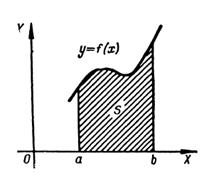
CATEGORIES:
BiologyChemistryConstructionCultureEcologyEconomyElectronicsFinanceGeographyHistoryInformaticsLawMathematicsMechanicsMedicineOtherPedagogyPhilosophyPhysicsPolicyPsychologySociologySportTourism
Applications to the computation of the integrals of plane figures areas. Calculation the arc length, the amount of body rotation. The improper integral
LECTURE PLAN:
1. Application to the computation of definite integrals of plane figures areas 2. Calculations of the length, the amount of body rotation 3. The improper integral
Applications of definite integrals
The areas of plane figures
If a continuous curve is defined in rectangular coordinates by the equation
points x=a and x =b and by a segment of the x-axis
In the more general case, if the area S is bounded by two continuous curves
If the curve is defined by equations in parametric form
where If a curve is defined in polar coordinates by the equation
Fig. 2. which correspond to the values
The arc length of a curve
The arc length s of a curve y=f(x) contained between two points with abscissas x=a and x=b is
If a curve is represented by equations in parametric form
where
If a curve is defined by the equation
where
The volume of a solid of revolution
The volumes of solids formed by the revolution of a curvilinear trapezoid [bounded by the curve y=f(x), the x-axis and two vertical lines x=a and x=b] about the x-axis and y-axes are expressed, respectively, by the formulas:
The Area of a Surface of Revolution
The area of a surface formed by the rotation, about the x-axis, of an arc of the curve y=f(x) between the points x=a and x=b, is expressed by the formula
If a curve is represented by equations in parametric form where
Date: 2015-01-02; view: 1019
|
 the area of the curvilinear trapezoid bounded by this curve, by two vertical lines at the
the area of the curvilinear trapezoid bounded by this curve, by two vertical lines at the
 , is given by the formula
, is given by the formula .
. and
and  and by two vertical lines x=a and x=b, where
and by two vertical lines x=a and x=b, where  when
when  .
. and
and  then the area of the curvilinear trapezoid bounded by this curve, by two vertical lines (x=a and x=b), and by a segment of the x-axis is expressed by the integral
then the area of the curvilinear trapezoid bounded by this curve, by two vertical lines (x=a and x=b), and by a segment of the x-axis is expressed by the integral ,
, and
and  are determined from the equations
are determined from the equations  and
and 
 on the interval
on the interval  .
. , then the area of the sector AOB (Fig. 2), bounded by an arc of the curve, and by two radius vectors OA and OB,
, then the area of the sector AOB (Fig. 2), bounded by an arc of the curve, and by two radius vectors OA and OB,
 and
and  is expressed by the integral
is expressed by the integral .
. .
. ,
, ,
, and
and  are the values of the polar angle at the extreme points of the arc.
are the values of the polar angle at the extreme points of the arc. and
and  .
. .
. then
then  ,
,